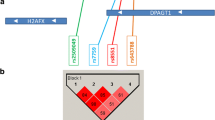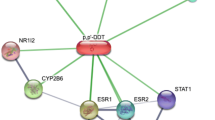Summary
Laboratory and bioinformatics studies have suggested that immunoglobulin μ-binding protein 2 (IGHMBP2) is involved in DNA repair, replication and recombination. Using 1067 cases and 1110 controls from a population-based case-control study, we sought to clarify the potential role of the IGHMBP2 Thr671Ala polymorphism (A to G substitution) alone and as a modifier of the effects for cigarette smoking and PAH–DNA adducts on breast cancer risk. Unconditional logistic regression was used to estimate odds ratios (OR) and 95% confidence intervals (CI). Overall, there was no significant association between the IGHMBP2 variant-G allele and breast cancer risk (OR = 1.1, 95% CI = 0.9–1.3). Increased risk was found among women who had detectable PAH–DNA adducts and carried at least one variant-G allele (OR = 1.4, 95% CI = 1.0–1.8, p for trend = 0.01) compared to women carrying the wild-type AA genotype and with non-detectable adducts. Smokers carrying the IGHMBP2 variant-G allele had no significant increased breast cancer risk compared with non-smoking women with the AA genotype. Heavy smokers (>31 pack years) had a statistically significant association with breast cancer risk (OR=2.0, 95% CI=1.2–3.3) relative to nonsmokers with the AA genotype though the magnitude of association was not different than heavy smokers (> 31 pack years) with the AA genotype (OR=1.6, 95% CI=0.9–2.6). Overall our study observes only modestly higher effect estimates for PAH-DNA adduct exposure and cigarette smoking among those with the high-risk genotype, but these differences are not statistically significant. Additional studies focused on the biological function of the variant-G allele and interactions with other genetic polymorphisms are necessary to confirm our findings.
Similar content being viewed by others
References
Hamajima N, Hirose K, Tajima K, et al. Alcohol, tobacco and breast cancer-collaborative reanalysis of individual data from 53 epidemiological studies, including 58,515 women with breast cancer and 95,067 women without the disease Br J Cancer 87:1234–1245, 2002
Terry PD, Rohan TE Cigarette smoking and the risk of breast cancer in women: a review of the literature Cancer Epidemiol Biomarkers Prev 11:953–971, 2002
Band PR,Le ND,Fang R, Deschamps M Carcinogenic and endocrine disrupting effects of cigarette smoke and risk of breast cancer Lancet 360:1044–1049, 2002
Palmer JR, Rosenberg L Cigarette smoking and the risk of breast cancer Epidemiol Rev 15:145–156, 1993
Johnson KC Accumulating evidence on passive, active smoking and breast cancer risk Int J Cancer 117:619–628, 2005
Russo J,Tay LK, Russo IH Differentiation of the mammary gland and susceptibility to carcinogenesis Breast Cancer Res Treat 2:5–73, 1982
Reynolds P,Hurley S,Goldberg DE, et al. Active smoking, household passive smoking, and breast cancer: evidence from the California Teachers Study J Natl Cancer Inst 96:29–37, 2004
Egan KM,Stampfer MJ,Hunter D, et al. Active and passive smoking in breast cancer: prospective results from the Nurses’ Health Study Epidemiology 13:138–145, 2002
Kropp S, Chang-Claude J Active and passive smoking and risk of breast cancer by age 50 years among German women Am J Epidemiol 156:616–626, 2002
Gammon MD,Eng SM,Teitelbaum SL, et al. Environmental tobacco smoke and breast cancer incidence Environ Res 96:176–185, 2004
Coyle YM The effect of environment on breast cancer risk Breast Cancer Res Treat 84:273–288, 2004
Menzie CA, Potocki BB, Santodonato J. Exposure to carcinogenic PAHs in the environment Environ Sci Tech 26:1278–1284, 1992
Li D,Wang M,Dhingra K, Hittelman WN Aromatic DNA adducts in adjacent tissues of breast cancer patients: clues to breast cancer etiology Cancer Res 56:287–293, 1996
Rundle A,Tang D,Hibshoosh H, et al. The relationship between genetic damage from polycyclic aromatic hydrocarbons in breast tissue and breast cancer Carcinogenesis 21:1281–1289, 2000
Gammon MD,Santella RM,Neugut AI, et al. Environemntal toxins and breast cancer on Long Island. I. Polycyclic aromatic hydrocarbon DNA adductsCancer Epidemiol Biomarkers Prev 11:677–685, 2002
Shantakumar S,Gammon MD,Eng SM, et al. Residential environmental exposures and other characteristics associated with detectable PAH–DNA adducts in peripheral mononuclear cells in a population-based sample of adult females J Expo Anal Environ Epidemiol 15:482–490, 2005
Santella RM,Gammon MD,Zhang YJ, et al. Immunohistochemical analysis of polycyclic aromatic hydrocarbon-DNA adducts in breast tumor tissue Cancer Lett 154:143–149, 2000
Motykiewicz G,Malusecka E,Michalska J, et al. Immunoperoxidase detection of polycyclic aromatic hydrocarbon-DNA adducts in breast tissue sections Cancer Detect Prev 25:328–335, 2001
Wu X,Zhao H,Suk R, Christiani DC Genetic susceptibility to tobacco-related cancer Oncogene 23:6500–6523, 2004
Tang MS,Pierce JR,Doisy RP,Nazimiec ME, MacLeod MC Differences and similarities in the repair of two benzo[a]pyrene diol epoxide isomers induced DNA adducts by uvrA, uvrB, and uvrC gene products Biochemistry 31:8429–8436, 1992
Jeffy BD,Chirnomas RB, Romagnolo DF Epigenetics of breast cancer: polycyclic aromatic hydrocarbons as risk factors Environ Mol Mutagen 39:235–244, 2002
Matullo G,Guarrera S,Carturan S, et al. DNA repair gene polymorphisms, bulky DNA adducts in white blood cells and bladder cancer in a case-control study Int J Cancer 92:562–567, 2001
Matullo G,Peluso M,Polidoro S, et al. Combination of DNA repair gene single nucleotide polymorphisms and increased levels of DNA adducts in a population-based study Cancer Epidemiol Biomarkers Prev 12:674–677, 2003
Hoffmann H,Isner C,Hogel J, Speit G Genetic polymorphisms and the effect of cigarette smoking in the comet assay Mutagenesis 20:359–364, 2005
Terry MB,Gammon MD,Zhang FF, et al. Polymorphism in the DNA repair gene XPD, polycyclic aromatic hydrocarbon-DNA adducts, cigarette smoking, breast cancer risk Cancer Epidemiol Biomarkers Prev 13:2053–2058, 2004
Shen J,Gammon MD,Terry MB, et al. Polymorphisms in XRCC1 modify the association between PAH–DNA adducts, cigarette smoking, dietary antioxidants and breast cancer risk Cancer Epidemiol Biomarkers Prev 14:336–342, 2005
Grohmann K,Rossoll W,Kobsar I, et al. Characterization of Ighmbp2 in motor neurons and implications for the pathomechanism in a mouse model of human spinal muscular atrophy with respiratory distress type 1 (SMARD1) Hum Mol Genet 13:2031–2042, 2004
Maystadt I,Zarhrate M,Landrieu P, et al. Allelic heterogeneity of SMARD1 at the IGHMBP2 locus Hum Mutat 23:525–526, 2004
Grohmann K,Schuelke M,Diers A, et al. Mutations in the gene encoding immunoglobulin mu-binding protein 2 cause spinal muscular atrophy with respiratory distress type 1 Nat Genet 29:75–77, 2001
Savas S,Kim DY,Ahmad MF,Shariff M, Ozcelik H Identifying functional genetic variants in DNA repair pathway using protein conservation analysis Cancer Epidemiol Biomarkers Prev 13:801–807, 2004
Fukita Y,Mizuta TR,Shirozu M,Ozawa K,Shimizu A, Honjo T The human S mu bp-2, a DNA-binding protein specific to the single-stranded guanine-rich sequence related to the immunoglobulin mu chain switch region J Biol Chem 268:17463–17470, 1993
Mizuta TR,Fukita Y,Miyoshi T,Shimizu A, Honjo T Isolation of cDNA encoding a binding protein specific to 5′-phosphorylated single-stranded DNA with G-rich sequences Nucl Acids Res 21:1761–1766, 1993
Mooney S Bioinformatics approaches, resources for single nucleotide polymorphism functional analysis Brief Bioinform 6:44–56, 2005
Gammon MD,Neugut AI,Santella RM, et al. The Long Island Breast Cancer Study Project: description of a multi-institutional collaboration to indentify environmental risk factors for breast cancer Breast Cancer Res Treat 74:235–254, 2002
Chen X,Levine L, Kwok PY Fluorescence polarization in homogeneous nucleic acid analysis Genome Res 9:492–498, 1999
Gammon MD, Sagiv SK, Eng SM, Shantakumar S, Gaudet MM, Teitelbaum SL, Britton JA, Terry MB, Wang LW, Wang Q, Stellman SD, Beyea J, Hatch M, Kabat GC, Wolff MS, Levin B, Neugut AI, Santella RM: Polycylic aromatic hydrocarbon (PAH)-DNA adducts and breast cancer: a pooled analysis. Arch Environ Health, in press, 2006
Hosmer DW. Applied Logistic Regression John Wiley & Sons New York 1989
Metsola K, Kataja V, Sillanpaa P, et al. XRCC1 and XPD genetic polymorphisms, smoking and breast cancer risk in a Finnish case-control study Breast Cancer Res 7:R987–R997, 2005
Duell EJ, Millikan RC, Pittman GS, et al. Polymorphisms in the DNA repair gene XRCC1 and breast cancer Cancer Epidemiol Biomarkers Prev 10:217–222, 2001
Shen J, Terry MB, Gammon MD, et al. MGMT genotype modulate the associations between cigarette smoking, dietary antioxidants and breast cancer risk Carcinogenesis 26:2131–2137, 2005
El-Bayoumy K Environmental carcinogens that may be involved in human breast cancer etiology Chem Res Toxicol 5:585–590, 1992
Rundle A,Tang D,Zhou J,Cho S, Perera F The association between glutathione S-transferase M1 genotype and polycyclic aromatic hydrocarbon-DNA adducts in breast tissue Cancer Epidemiol Biomarkers Prev 9:1079–1085, 2000
Bonner MR, Han D, Nie J, et al. Breast cancer risk and exposure in early life to polycyclic aromatic hydrocarbons using total suspended particulates as a proxy measure Cancer Epidemiol Biomarkers Prev 14:53–60, 2005
Tang D, Cho S, Rundle A, et al. Polymorphisms in the DNA repair enzyme XPD are associated with increased levels of PAH–DNA adducts in a case-control study of breast cancer Breast Cancer Res Treat 75:159–166, 2002
Goode EL, Ulrich CM, Potter JD Polymorphisms in DNA repair genes and associations with cancer risk Cancer Epidemiol Biomarkers Prev 11:1513–1530, 2002
Acknowledgements
For their valuable contributions to the LIBCSP, the authors thank members of the Long Island Breast Cancer Network; the 31 participating institutions on Long Island and in New York City, NY; our National Institutes of Health collaborators, Gwen Colman, PhD, National Institutes of Environmental Health Sciences; G. Iris Obrams, MD, PhD formerly of the National Cancer Institute; members of the External Advisory Committee to the population-based case-control study: Leslie Bernstein, PhD, (Committee chair); Gerald Akland, MS; Barbara Balaban, MSW; Blake Cady, MD; Dale Sandler, PhD; Roy Shore, PhD; and Gerald Wogan, PhD; as well as other collaborators who assisted with various aspects of our data collection efforts including Gail Garbowski, MPH, Julie Britton, PhD, Mary S. Wolff, PhD, Steve Stellman, PhD, Maureen Hatch, PhD, Geoff Kabat PhD, Bruce Levin, PhD H. Leon Bradlow, PhD; David Camann, BS; Martin Trent, BS; Ruby Senie, PhD; Carla Maffeo, PhD; Pat Montalvan; Gertrud Berkowitz, PhD; Margaret Kemeny, MD; Mark Citron, MD; Freya Schnabel, MD; Allen Schuss, MD; Steven Hajdu, MD; and Vincent Vinceguerra, MD. PAH–DNA adducts (detected by Lianwen Wang, Qiao Wang) and genotyping were completed in Dr Santella’s lab. Funded in part by grants U01 CA/ES66572, P30ES09089, P30ES10126, and K07CA90685-02 from the National Cancer Institute and the National Institute of Environmental Health Sciences, an award from the Breast Cancer Research Foundation and gifts from private citizens.
Author information
Authors and Affiliations
Corresponding author
Rights and permissions
About this article
Cite this article
Shen, J., Beth Terry, M., Gammon, M.D. et al. IGHMBP2 Thr671Ala polymorphism might be a modifier for the effects of cigarette smoking and PAH–DNA adducts to breast cancer risk. Breast Cancer Res Treat 99, 1–7 (2006). https://doi.org/10.1007/s10549-006-9174-3
Received:
Accepted:
Published:
Issue Date:
DOI: https://doi.org/10.1007/s10549-006-9174-3




